Hitachi Deskstar 7K1000 in RAID 0: Is Two Terabytes really better than One?
by Gary Key on April 19, 2007 12:15 AM EST- Posted in
- Storage
iPeak Video/Audio Tests
The iPeak based Video/Audio benchmarks are designed around simulating media encoding and HTPC activities. These are basic benchmarks at this time but this section will be expanded once we start testing under Vista. Our change to a better performing dual core processor will assist us in maintaining a balance between the CPU and Storage systems during the trace file creation and benchmarking processes. These benchmarks are CPU intensive in nature but also require a balanced storage system with the ability at times to handle read and write requests simultaneously in a very efficient manner.
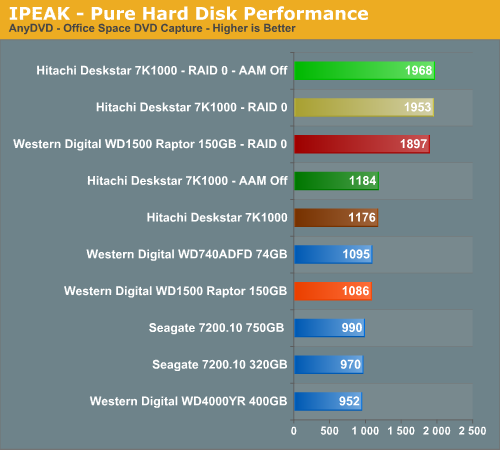
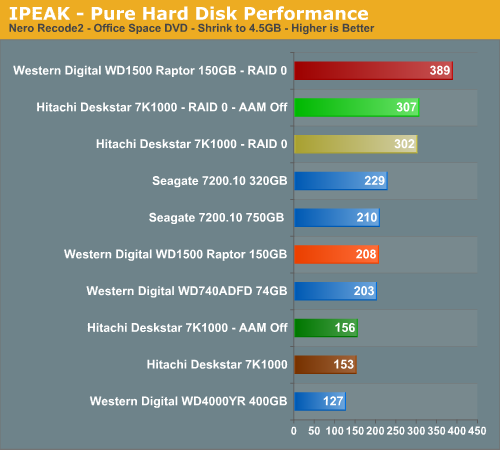
The AnyDVD benchmark is heavily weighted to write requests. The results show a common pattern in write intensive situations with the RAID 0 setups improving about 66% over their single drive counterparts. The 7K1000 scores particularly well in these write intensive benchmarks due to its areal density and large cache design.
The Nero Recode 2 benchmark is weighted to streaming read requests at the start of the test but is balanced by continuous write operations during the encoding process. This benchmark is one of the most demanding ones in our test suite with the disk being active the entire trace file with several 100% utilization peaks. The results show an almost 93% improvement in hard disk performance with RAID 0. We believe this is one of the few tests where RAID 0 on the desktop will make an actual difference in real-world performance.
The individual drive results surprised us as we expected the Hitachi with its 32 MB cache and high sustained transfer rates to score near the Raptors. However, it turns out after reviewing the trace file results it was obvious that the 7K1000 was hampered by its inability to process large data blocks in sequential order efficiently as it had a number of buffer overruns during the read portion of the tests. This indicates to us the drive firmware is probably tuned for non-sequential read/writes as the rest of our tests indicate. The 32 MB cache should have easily compensated for any potential large block issues in this test.
iPeak Game Installation Tests
Our iPeak based Game Installation benchmarks simply show the ability of the hard drive to write data as quickly as possible to the disc based upon the installation software instructions. As detailed in our iPeak setup description we installed the games from our source drive in order to eliminate the optical drive bottleneck. In separate application timing we witnessed basically the same percentage spread when installing the games via our DVD drive so these results are representative of actual installation performance.
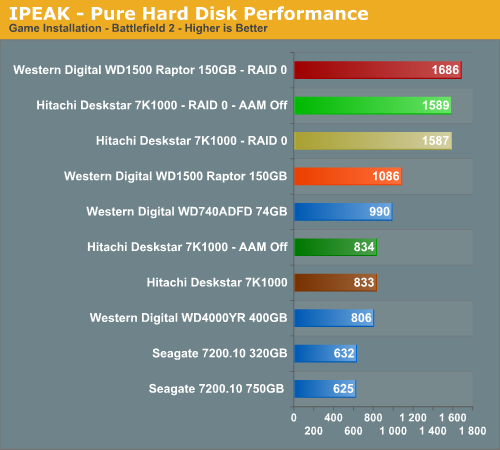
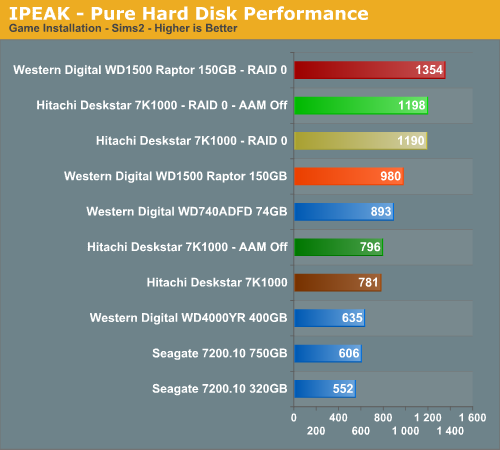
The Raptors once again finish at or near the top in our gaming tests due to their rotational and random access speeds. Our 7K1000 drive finishes ahead of the other 7200rpm drives with a great deal of benefit going to the 32 MB cache and high sustained transfer rates. In the RAID 0 results we see the Raptor scores improving 38% in The Sims2 and 55% in BF2. The 7K1000 benefits greatly from RAID 0 in these tests with improvements of 50% in The Sims2 and 90% in BF2 with the Raptors once again showing their strength in gaming.
We need to remember these tests reflect pure hard drive performance and will be mitigated by the overall system platform as we will see in our application tests. These tests are basically designed around continual read/write requests that favor large cache sizes, properly tuned firmware, and high sustained transfer rates.
iPeak Game Play Tests
The iPeak based Game Play tests are centered on the benefits of having a hard disk that can load non-linear or sequential data files quickly without interrupting the flow of the game.

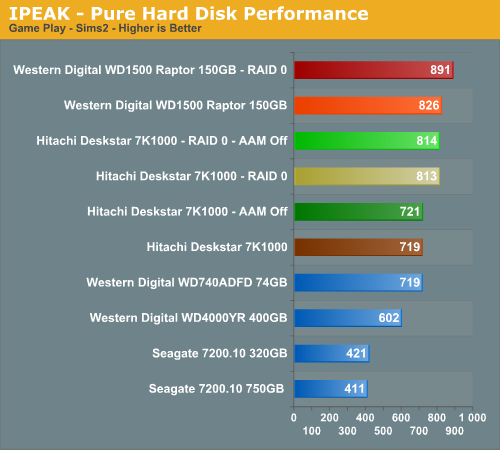
In game play the RAID 0 setups hold a 7% to 12% advantage in these benchmarks. We noticed in the trace files that performance improved only when the game levels changed. The best overall gaming performance with a SATA drive is still provided by the Raptors. However, considering the space, noise levels, and cost per GB advantages of the Hitachi drive, we are willing to change our recommendation for most users (though plenty will feel 1TB is too big and would rather go with a 500GB model).
The iPeak based Video/Audio benchmarks are designed around simulating media encoding and HTPC activities. These are basic benchmarks at this time but this section will be expanded once we start testing under Vista. Our change to a better performing dual core processor will assist us in maintaining a balance between the CPU and Storage systems during the trace file creation and benchmarking processes. These benchmarks are CPU intensive in nature but also require a balanced storage system with the ability at times to handle read and write requests simultaneously in a very efficient manner.


The AnyDVD benchmark is heavily weighted to write requests. The results show a common pattern in write intensive situations with the RAID 0 setups improving about 66% over their single drive counterparts. The 7K1000 scores particularly well in these write intensive benchmarks due to its areal density and large cache design.
The Nero Recode 2 benchmark is weighted to streaming read requests at the start of the test but is balanced by continuous write operations during the encoding process. This benchmark is one of the most demanding ones in our test suite with the disk being active the entire trace file with several 100% utilization peaks. The results show an almost 93% improvement in hard disk performance with RAID 0. We believe this is one of the few tests where RAID 0 on the desktop will make an actual difference in real-world performance.
The individual drive results surprised us as we expected the Hitachi with its 32 MB cache and high sustained transfer rates to score near the Raptors. However, it turns out after reviewing the trace file results it was obvious that the 7K1000 was hampered by its inability to process large data blocks in sequential order efficiently as it had a number of buffer overruns during the read portion of the tests. This indicates to us the drive firmware is probably tuned for non-sequential read/writes as the rest of our tests indicate. The 32 MB cache should have easily compensated for any potential large block issues in this test.
iPeak Game Installation Tests
Our iPeak based Game Installation benchmarks simply show the ability of the hard drive to write data as quickly as possible to the disc based upon the installation software instructions. As detailed in our iPeak setup description we installed the games from our source drive in order to eliminate the optical drive bottleneck. In separate application timing we witnessed basically the same percentage spread when installing the games via our DVD drive so these results are representative of actual installation performance.


The Raptors once again finish at or near the top in our gaming tests due to their rotational and random access speeds. Our 7K1000 drive finishes ahead of the other 7200rpm drives with a great deal of benefit going to the 32 MB cache and high sustained transfer rates. In the RAID 0 results we see the Raptor scores improving 38% in The Sims2 and 55% in BF2. The 7K1000 benefits greatly from RAID 0 in these tests with improvements of 50% in The Sims2 and 90% in BF2 with the Raptors once again showing their strength in gaming.
We need to remember these tests reflect pure hard drive performance and will be mitigated by the overall system platform as we will see in our application tests. These tests are basically designed around continual read/write requests that favor large cache sizes, properly tuned firmware, and high sustained transfer rates.
iPeak Game Play Tests
The iPeak based Game Play tests are centered on the benefits of having a hard disk that can load non-linear or sequential data files quickly without interrupting the flow of the game.


In game play the RAID 0 setups hold a 7% to 12% advantage in these benchmarks. We noticed in the trace files that performance improved only when the game levels changed. The best overall gaming performance with a SATA drive is still provided by the Raptors. However, considering the space, noise levels, and cost per GB advantages of the Hitachi drive, we are willing to change our recommendation for most users (though plenty will feel 1TB is too big and would rather go with a 500GB model).










48 Comments
View All Comments
photoguy99 - Thursday, April 19, 2007 - link
You have tested XP 32-bit which uses the "ScsiPort" storage system.This artificially limits results using Raid.
Vista 32, Vista x64, and XP x64 all use the "StorPort" storage system, which is much faster and doesn't limit Raid results.
You could add 4 or 8 drives in Raid 0 and your transfer rates would not change much.
This should really be part of the discussion for the article.
yyrkoon - Thursday, April 19, 2007 - link
Funny that, last time I personally did a dirrect comparrison of a 3xRAID0 array in Vista, it was 30-40MB/s slower comparred to the same array in XP Pro.Nothing changed, only the OS.
photoguy99 - Thursday, April 19, 2007 - link
Perhaps in your case the Vista driver was not as optimized as the XP driver or was not using storport.However, it is absolutely invalid to benchmark raid performance on XP 32-bit if your goal is to test hardware rather than OS specific results.
Microsoft reference:
http://msdn2.microsoft.com/en-us/library/ms803198....">http://msdn2.microsoft.com/en-us/library/ms803198....
AllanLim - Thursday, April 19, 2007 - link
http://kakaku.com/item/05300415786/">http://kakaku.com/item/05300415786/Along with every other pc component, this probably comes at 20-30% premium compared to Stateside when it becomes available, but at least you can but it here.
Myrandex - Thursday, April 19, 2007 - link
Two 250GB drives in Raid 0. I dunno, I still feel that it helps with some load times on large maps on games and large numbers of file transfers at once, but I could be full of it. I do keep an off disk backup though that is pretty current.Jason
Sunrise089 - Thursday, April 19, 2007 - link
Sorry to double-post, but the end of the article says:" As stated in both articles, we believe leaving AAM and NCQ turned provides the best user experience with this drive."
I think there should be an "on" or "off" after "turned".
Sunrise089 - Thursday, April 19, 2007 - link
I have a long-running arguement with another PC enthusiest about the relative merit of RAID 0. Some people just cannot get it through their heads that no matter how great the idea sounds, the performance just isn't justified by the cost. At all. With video card price/performance scaling perfectly, and CPU and memory scaling at least OK, it's insane to spend hundreds of dollars on a second hard drive and gain a few percentage points in real-world tests. Thanks Anandtech for keeping the real-world focus of these articles.mesyn191 - Saturday, April 21, 2007 - link
Depends how its done...These software RAID controllers (yes NVRAID, Intel Matrix RAID, Silicon Image 3112/4 etc, Promise, Highpoint are all software RAID controllers that often act more like storage subsystem DE-celerators and often slow things down...) that Anandtech keeps using to demonstrate the pointlessness of RAID 0 really only prove how crappy software RAID controllers are. If you use a "real" enterprise class RAID controller that has a dedicated CPU and significant cache you'll see some real world performance improvements, even with doing things like loading games which is a far from ideal work load for RAID 0. The problem is most of these "real" RAID controllers tend to cost ~$300, and that is for a cheap one, high end versions can easily cost thousands of dollars and most people don't want to spend that much on storage. Most of these enterprise class controllers also tend to have issues working with desktop motherboards, they're really meant for use in server motherboards and so they won't even boot up properly in alot of them, just read up on all the issues people tend to have getting the Areca 1210 (probably the most commonly used enterprise class RAID card in the enthusiast PC crowd) PCIe RAID cards working in commodity consumer grade motherboards.
Of course another nice thing about those enterprise class RAID controllers is most of them support multiple levels of RAID at the same time, so you can have a RAID 0 set and a RAID 5 set on the same bunch of hard drives, providing you a good way to safe guard your data and get a performance benefit.
PenGun - Friday, April 20, 2007 - link
K .... maybe you can tell me how I'm gonna get a solid write of 150MB/sec any other way. My camera in HD SDI needs to move that much data.RAID 0 or perhaps RAID 5 (to be tested soon) is the only way. 4 Western Digital 500G drives is my way of handling that fire hose of data.
Oh go back to your games it really does not matter, it's just my problem right now. It is my desktop when it's full. It's easier to crunch the massive files in situ.
yyrkoon - Thursday, April 19, 2007 - link
Some people just can not seem to get it through their heads, that not everyone plays games, or surfs the web, on a home desktop PC. Video editing applications that require 65MB/s substained transfers rates, will require either a very fast disk, or two lesser drives striped.
Since most enterprise drives cost an arm and a leg, I think running RAID0 for this application, or something that NEEDS the throughput justifies the cost. Now, I personally DO run RAID0 on my home desktop, and I think it is more than justified, but I do not expect it to work wonders, and I definately know, it will not make my system boot faster, will not make a First Person Shooter faster (except, perhaps level load times, which is pretty much moot).
Now, Imagine spending 2x $400 for RAID1 . . . that is what I call a waste of money, although, with these hitachi drives, who knows how reliable they are. The point here, being, you can not tell anyone what they need, or want in a desktop, because you really have not a clue what they really need / want. This being said, RAID0 for most people probably is overkill.